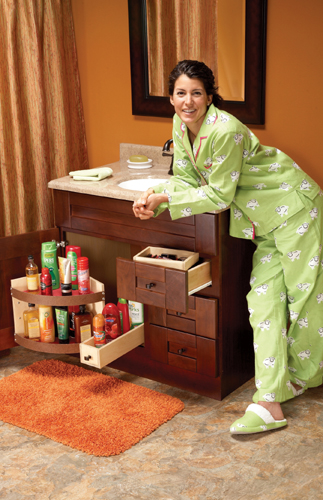

WHAT IT TAKES
Time: 1 day
Skill level: Beginner
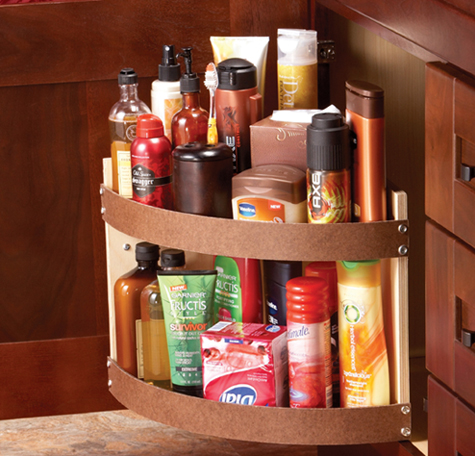
1 Swing-out shelf
Get everything within reach! This spacious, double-level shelving unit pivots in and out effortlessly.
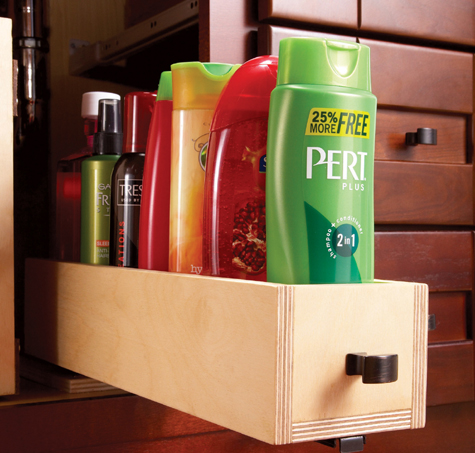
2 Mini rollout
No more tipping! This rollout has taller sides for taller products as well as full-extension hardware.
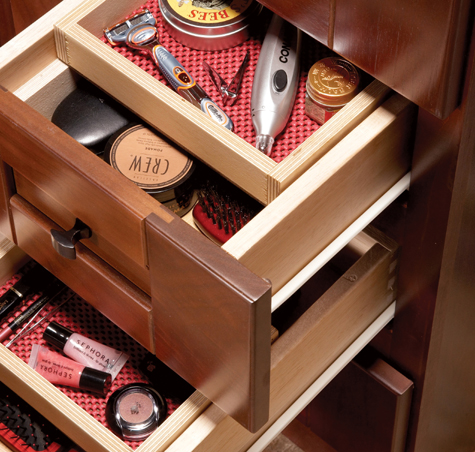
3 Drawer top trays
Get organized! Make these nifty sliding trays for all your vanity drawers.
Most vanities are poor storage spaces because they’re designed for the convenience of plumbers, not for you. While that big, open box is nice for installing pipes, it leaves you with jumbled storage and wasted space.
But you can convert that box into useful space by installing any or all of these three upgrades. You’ll expand the real estate under your sink and make it easy to find anything in seconds. Even a beginning DIYer can build all three projects in two or three days, for under $100.
1 Swing-out shelf
Here’s the answer to all that inaccessible clutter on the floor of your vanity. With one pull, you can bring stored items out of the dark recesses and into easy reach.
Chances are, the measurements shown in Figure A won’t be best for your vanity. The surest way to determine the right size for your shelf is to cut a quarter circle from cardboard and test the fit. If your vanity has double doors, you can still build this shelf, but you may need to open both doors to swing it out. Here are some tips for building your swing-out shelf:
• To make the curved shelves, just mark a half circle and then cut it into two equal quarter circles.
• A pneumatic brad nailer makes assembly a cinch. If you don’t have a brad nailer, use trim screws. The awkward shape of the shelves makes hand-nailing difficult. Whether you use nails or screws, also use glue.
• You can finish your shelf with a couple of coats of polyurethane. A can of spray lacquer is also a good option.
• Piano hinges come in various lengths, but you probably won’t find exactly what you need for your shelf. That’s OK; You can cut it to length with a hacksaw.
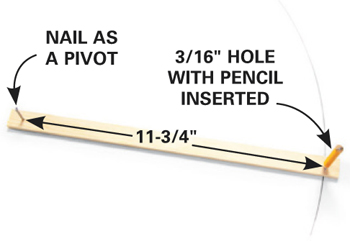
A homemade trammel is perfect for marking out the curved shelves.
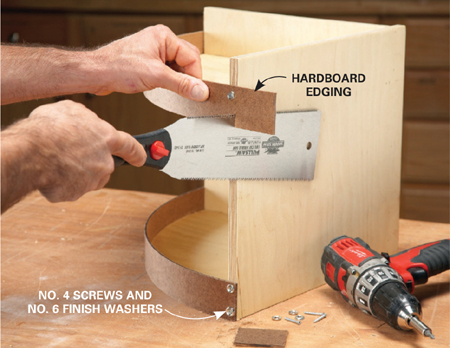
1
Install the edging, then trim it. Cut the hardboard edging a few inches too long, fasten it with screws and slice off the excess with a fine-tooth saw. Finish washers give the screws a neater look.

2
Hang it on a hinge. Raise the shelf with spacers and align the shelf back with the inside edge of the face frame. Screw the piano hinge to the shelf back, then to the cabinet. You may have to notch the shelf back to clear the door hinge.
2 Mini rollout
This handy little rollout has tall sides, fronts and backs to keep bottles and cleaners in place as you open it. Alter the dimensions given in Figure B to suit your needs. Here are some building tips:
• Assemble the drawer boxes with glue plus trim screws, finish nails or brad nails.
• Shown is a 14-in. “full-extension” drawer slide. This type of slide is typically mounted on the side of a drawer, but it also works well as a light-duty undermount slide. If your home center doesn’t carry full-extension slides in the length you need, go to any online cabinet hardware supplier. You can use a standard undermount slide, but your tray won’t extend fully.
• Finish the rollout with two coats of polyurethane or spray lacquer.
• If you add a cabinet pull as shown here, be sure to set the base back a bit so the vanity door can close.
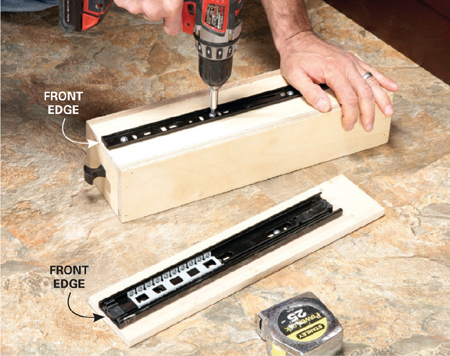
1
Mount the drawer slides. Separate the two parts of the drawer slide. Screw them to the tray and the base, aligned flush at the fronts.
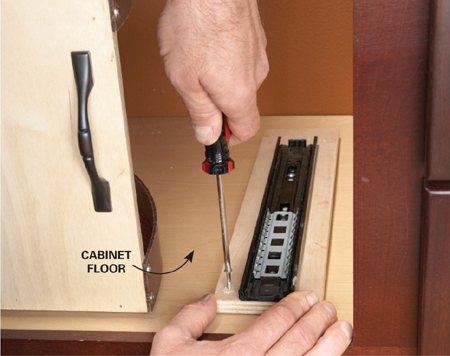
2
Elevate the drawer slide with a separate base. Fasten the tray base to the cabinet floor with No. 6 x 1-in. screws, then slide on the drawer.
3 Drawer top tray
Drawers are often too deep for small bathroom stuff like razors, medicine and cosmetics. That means wasted space. These handy sliding trays reduce that waste and increase drawer real estate by 50 percent.
• To size the tray, measure the drawer: Subtract 1/16 in. from the width of the drawer space and divide the length in half. Cut a piece of 1/8-in. hardboard this size.
• You can make the tray any depth you like. If the opening in the vanity is taller than the height of the drawer, your tray can protrude above the drawer sides.
• Finish the tray with a couple of coats of polyurethane or spray lacquer.
• Stored items tend to slide around in the trays, so add shelf liner (available at home centers and discount stores).
Figure C
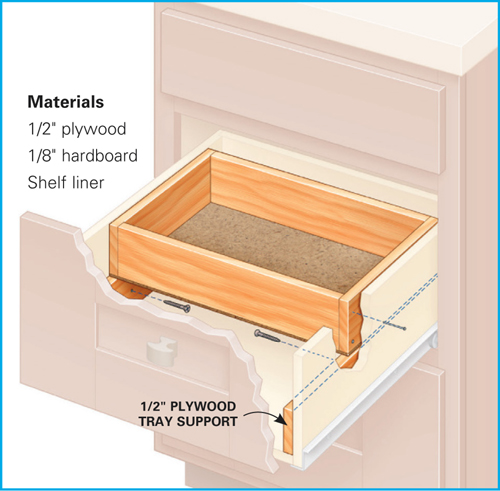
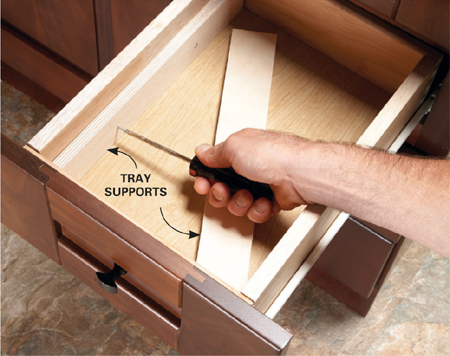
1
Add tray supports. Fasten strips of plywood to the drawer to support the tray. You only need two screws per support.
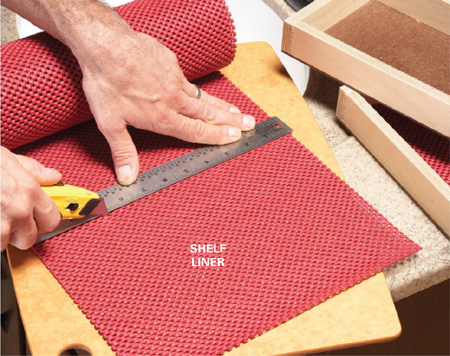
2
Line the trays. Cut shelf liner to fit the trays. Liner helps stored items stay put when you slide the tray.
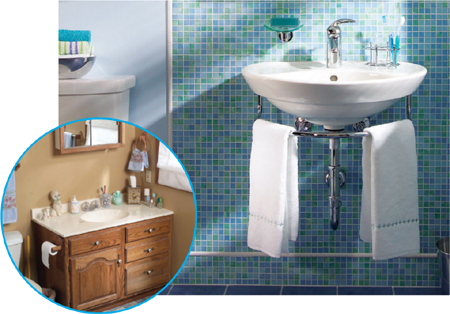
If you can get by without a vanity, a great way to make a small bathroom feel bigger is to replace the vanity with a stylish wall-hung sink. Visit familyhandyman.com and search “wall hung sink” for complete how-to instructions.
• Does your bathroom need an overhaul? Search for “bathroom remodel” to find complete step-by-step projects.
• Your feet will love a warm bathroom floor. Search for “in-floor heat” to see how to install an electric heat system.
• Drawer slides don’t slide? Search for “drawer slide” to see how to replace them.
• Got bathroom clutter? We have tips and projects galore. Search for “bathroom storage.”
• If this rollout is too small, search for “rollout” and get step-by-step instructions for a larger version.
• Old vanity top worn out? Glass tile makes an elegant, affordable replacement. And it’s easier than you think. Search for “vanity top.”